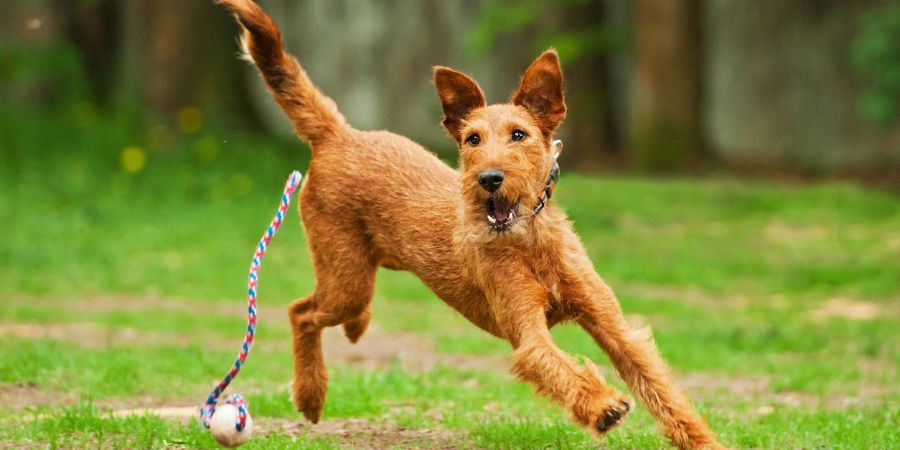What is Dog Behavior Training? The answer to this question could easily fill an entire book – and in fact, many volumes have been written on the topic. But we’ll try to provide a succinct overview for you here, so you know where (and how) to begin.
On that note, let’s dive in!
What is Dog Behavior Training?
Simply put, it’s the process of teaching a dog to respond in a desirable way to stimuli or cues. It involves rewarding desired behaviors and discouraging undesired behaviors through:
Furthermore, behavior modification training is an effective way for owners to teach their dogs important skills such as basic commands like sit, stay, and come. It can also be a valuable tool for working on more difficult issues such as fear, aggression, and separation anxiety.
Ultimately, the goal of dog behavior training is to create a strong bond between owner and pet while helping the dog learn better social skills and manners.
Why it Works
When done correctly, dog behavior training works wonders! What’s critical is that owners use positive reinforcement and ignore (rather than punish) unwanted behaviors. This approach encourages desirable behaviors to be repeated while also helping the dog trust their owner more.
In addition, utilizing operant conditioning can help dogs learn faster. The idea here is to provide prompt rewards or punishments that are most likely to shape the dog’s future responses. For instance, when teaching a dog the command “sit,” an owner should reward the dog with a treat or pat on the head immediately after they sit down – not several moments later.

Behavior Modification Dog Training vs. Obedience Training
Behavior Training
Though they’re often (and mistakenly) used interchangeably, behavior modification dog training is actually different from obedience training. Behavior modification training goes much deeper and can help address underlying issues like fear or aggression that might not be addressed by obedience training alone.
In other words, it helps “modify” a dog’s behavior by addressing underlying motivations and creating new, more desirable responses.
Obedience Training
On the other hand, obedience training is more focused on the “here and now” of a dog’s behavior. It teaches your pup how to respond to cues and commands like sit, stay, come, leave it, etc.
Obedience training is an important part of the behavior modification process; however, it does not address underlying motivations or behaviors that can lead to more serious issues. That’s why behavior modification dog training may be necessary for certain behavioral problems.
Pro Tip: To learn more about obedience training, check out this helpful blog article all about dog training for puppies!
10 Examples of Dog Behavior to Change
Here are 10 common behavioral issues that can be addressed through behavior modification dog training, as well as tips on how to change them:
Example #1: Jumping
Unwanted jumping is one of the most common behavior problems that owners face. It can be annoying, intimidating to guests and even dangerous for small children.
How to Change This Behavior
- Use cues like “off” or “down” when your pup jumps on you or someone else.
- Reward desired behaviors with praise, treats, and toys.
- Ignore the unwanted behavior whenever possible.
- Don’t yell at the dog – instead, redirect their attention elsewhere.
Example #2: Chewing/Destructive Behavior
This is another common problem that can be solved through dog behavior training. Dogs often chew as a way to relieve stress or boredom. On the other hand, they may exhibit destructive behaviors like digging or barking excessively as a way to get attention or explore their environment.
How to Change This Behavior
- Provide plenty of appropriate chew toys.
- Remove items they shouldn’t be chewing on.
- Reward desired behaviors with treats, praise, and playtime.
- Redirect their attention when they start to exhibit destructive behaviors.
Example #3: Barking
Unwanted and/or excessive barking is another common behavior problem faced by both dog owners and their neighbors. Finding ways to reduce your pup’s barking is important for keeping the peace at home (and in your neighborhood).
How to Change This Behavior
- Identify the cause of the barking (e.g. attention-seeking, fear, excitement).
- Provide plenty of exercise and mental stimulation for your pup.
- Teach them alternative behaviors like quiet or sit when they start to bark.
- Reward desired behaviors with treats, praise, and playtime.

Example 4: Separation Anxiety
Separation anxiety can manifest itself in a variety of ways including excessive barking, chewing or digging. Furthermore, it’s an emotionally draining condition for both owners and their pups and can be difficult to deal with on your own.
How to Change This Behavior
- Provide plenty of exercise and mental stimulation during the day.
- Start leaving them alone for short periods of time and reward them with treats, praise, and playtime when they remain calm.
- Slowly increase the duration of time left alone.
Pro Tip: Learn more about how to effectively deal with your dog’s separation anxiety!
Example #5: Licking Too Much
Dogs can lick for a variety of reasons, but too much licking can become a nuisance. It’s important to establish boundaries with your pup and address the underlying causes of the licking behaviors.
How to Change This Behavior
- Provide plenty of exercise and mental stimulation during the day.
- Redirect their attention when they start to lick.
- Reward desired behaviors with treats, praise, and playtime.
- Ignore the unwanted behavior whenever possible.
Example #6: Bolting Through Doors
Dogs can be naturally inquisitive and eager to explore, making them prone to bolting through doors when opened. However, this behavior can be dangerous for both the pup and those around them.
It can be dangerous for the dog because they can easily wander off or get hit by a car. On the other hand, it can be dangerous for those around them because it can startle them or cause an accident (such as being knocked over).
How to Change This Behavior
- Teach them alternative behaviors like sit or stay when they start to bolt.
- Reward desired behaviors with treats, praise, and playtime.
- Ignore the unwanted behavior whenever possible.
- Make sure to always keep doors closed or blocked off if possible.
Example #7: Being an Attention Seeker
Dogs can be very demanding and often resort to attention-seeking behaviors when they feel neglected. If left unaddressed, these behaviors can become a nuisance and even worse, lead to destructive or aggressive behaviors when they aren’t constantly the star of the show. Luckily, this common problem can be resolved through consistent training and being provided with plenty of playtime and affection.
How to Change This Behavior
- Give them plenty of exercise and mental stimulation during the day.
- Teach them alternative behaviors like sit and stay when they start to demand attention.
- Ignore the unwanted behavior whenever possible.
- Reward desired behaviors with treats, praise, and playtime.
Example #8: Destructive Digging
Fun fact: before I was born, my mom got a Border Collie puppy named Sam. One day, while she and my father were out of the house, Sam dug a hole in the drywall. They patched it back up… Only to discover another hole right next to it the next time they left the house.
After a big of investigating, they figured out that this behavior was due to Sam’s separation anxiety. She didn’t like being left behind and was therefore trying to literally dig her way out of the house to try and be with them!
Whether this type of destructing digging is being done indoors or out in the yard, it can cause a lot of frustration for owners. What can you do?
How to Change This Behavior
- Find the root of the behavior so it can be addressed.
- Provide plenty of exercise and mental stimulation during the day.
- Give them an acceptable place to dig such as a designated sandbox.
- Reward desired behaviors with treats, praise, and playtime.
- Ignore the unwanted behavior whenever possible.
Example #9: Poor Socialization
Dogs that haven’t been properly socialized can become timid, scared, or aggressive towards people or other animals. This is why it’s important to start socializing your pup at an early age so they can learn how to interact with others.
How to Change This Behavior
- Work with a professional dog trainer and start building a strong bond between you and your dog.
- Introduce them to different people, other animals, and environments gradually.
- Enroll your dog in a socialization course.
- Reward desired behaviors with treats, praise, and playtime.
- Ignore the unwanted behavior whenever possible.
Interested in being a dog trainer yourself? Become fully trained and certified in as little as 5 simple steps – even if you have no experience!
Example #10: Overly Fearful
Fearful dogs can be difficult to deal with, as they tend to act out in aggressive ways when scared. So, it’s important to help them overcome their fear and feel safe and secure so that they can trust you and the environment around them.
How to Change This Behavior
- Work with a professional dog trainer and start building a strong bond between you and your dog.
- Introduce them to different people, other animals, and environments gradually.
- Enroll your dog in a socialization course.
- Identify the root of their fears and try to desensitize them to it with positive reinforcement training methods.
- Reward desired behaviors with treats, praise, and playtime.

Dog Behavior Training: Do’s and Don’ts
DOS:
- Create a consistent and predictable environment for your dog.
- Use positive reinforcement training methods, such as treats and praise.
- Provide plenty of exercise and mental stimulation during the day.
- Stay patient with your pup while they learn new behaviors.
DON’TS:
- Punish or reprimand bad behavior, as this will only lead to more behavioral issues.
- Forget to give your pup plenty of love and attention.
- Expect results overnight – it takes time for dogs to learn new behaviors!
How To Stop Aggressive Behavior with Behavior Modification Training
When it comes to aggressive behavior, the most important thing you can do is figure out what’s causing it. Some common reasons that dogs show aggression include (but aren’t limited to):
- Feeling threatened
- Being in pain
- Feeling possessive of something (like food or toys)
- Responding to fear, etc.
Using Dog Behavior Training to Address Aggression
Once you know the cause of a dog’s aggression, you can start working on changing their behavior with behavior modification techniques. Behavior modification involves changing the dog’s environment or introducing something new and positive into their lives in order to reduce aggression. This can include:
- Providing mental stimulation, like puzzle toys or interactive games
- Increasing exercise
- Offering food-filled puzzles to help with hunger-related aggression
- Teaching them new behaviors through positive reinforcement
It’s also important to give your pup plenty of love and attention as this will help them feel more secure in their environment. With a combination of these techniques, you should start to see results in a few weeks.
That said, it may sometimes take longer… And that’s okay! The key with behavior training is patience.
When to Seek Professional Help
If your pup’s aggression isn’t getting better after a few weeks of behavior modification, you may need to seek professional help. A certified dog trainer or behaviorist should be able to help you identify the root of the aggression. From there, you can work together to design a plan to get your pup back on track.
What if You’re a Professional Dog Trainer and the Aggression Proves to be Too Much?
That said, even the best dog trainers can find themselves in a situation where the aggression proves to be too much for them. In these cases, it’s important to reach out for help from a professional behaviorist who can provide you with more specialized tools and knowledge.
Frequently Asked Questions
Q: How should you get started with dog behavior training at home?
A: Start by creating a consistent and predictable environment for your pup. Implement positive reinforcement training methods, such as treats and praise, to reward desired behaviors. Also, provide plenty of exercise and mental stimulation during the day.
Q: Is it worth it to seek out the help of a professional dog trainer?
A: YES! So long as the trainer in question is qualified in behavioral training, it’s definitely worth seeking out their help. For one thing, they’re quite literally experts on the subject. Thus, your dog will have the best possible chance to reach their training goals.
What’s more, they can help you identify the root of any aggression-related issues and provide you with more specialized tools to help get them back on track.
PRO TIP: Here are the pros and cons of working as a professional dog trainer!
Q: How much is dog behavior training?
A: The cost of dog behavior training varies depending on the methods used, as well as the severity of the issue. Typically, this can be said for any/all dog training service rates provided by the experts. Generally speaking, it can range anywhere from $50 to hundreds of dollars. So, be sure to discuss pricing with potential trainers before making any decisions!

Q: What are the 3 D’s in dog training?
A: The 3 D’s stand for Distance, Distraction, and Duration. These are the three key elements of successful dog training.
Distance refers to how close or far away an owner should be from their pup during a training session. Distraction is all about staying focused – both you and your pup need to ignore any potential distractions around them in order to really focus in on the task at hand. Finally, Duration is about how long a training session should last – no more than 10-15 minutes!
Q: What are the 4 types of animal behavior?
A: The four types of animal behavior are:
- Innate
- Learned
- Social
- Adaptive
Innate behaviors are those that are instinctual to a species and exist with virtually no learning or practice. Learned behaviors come about through experience; these can be either positive or negative. Social behavior is related to interaction with other animals of the same species, while adaptive behavior involves changing responses to different situations.
Q: How long does behavioral training take for dogs?
A: The amount of time it takes for behavioral training to take effect depends on the severity of the issue at hand. For minor issues, such as barking or jumping, it can often be resolved in a few weeks. But for more difficult issues, such as aggression, it may take a few months or more. Thus, consistency and patience are key!
Q: What should you do if the dog shuts down?
A: If your dog is displaying signs of shutting down, such as becoming unresponsive to commands or ceasing movement altogether, it’s best to take a step back. This could be an indication that the behavior training process is overwhelming them. Take more breaks and provide more calming rewards like petting or soft voice tones until they’re ready to try again.
Q: What is an example of negative reinforcement in dog training?
A: The topic of negative reinforcement methods is a controversial one in the dog training world. The reason for this being, it can sometimes lead to more harm than good. An example of negative reinforcement in dog training is when a pup gets punished for displaying unwanted behaviors, such as barking or jumping. This could include scolding, leash corrections, and even physical punishment.
It’s important to note that the overwhelming majority of dog training professionals advise against negative reinforcement methods.
Q: How can you measure behavior change after training?
A: Measuring behavior change after a training course can be done in a variety of ways. You can track the progress by noting the frequency of behaviors that are being treated, such as barking or jumping. Additionally, you can measure their overall response to commands and rewards – if they seem more attentive and willing to learn than before, then it’s likely the training is working!
Ultimately, all these metrics can help you assess and gauge the effectiveness of a behavior modification dog training program. With the right approach and consistency, you can help set your pup up for success.
And if you’re not sure how to do any of this, simply ask a professional dog trainer! They’ll definitely be able to provide you with the guidance and advice you need to make sure your pup is on the right track.
Q: Should you put your dog down if their behavior doesn’t get better?
A: This is a very common question with a clear answer: absolutely not. Before making any drastic decisions, speak to your veterinarian or a professional trainer to determine the best course of action for you and your pup. Putting an animal down should always be seen as the very LAST resort after all other methods have been exhausted or are deemed too risky.
In our opinion, we like to believe that every dog can be redeemed, and that every issue can find its resolution. After all, how many videos do we see on the internet these days of dogs left to be euthanized – only to be saved and turned into loyal, loving family members?
So, before anything else, always remember that your pup is worth fighting for! If you find that every effort has been exhausted on your end, the solution may be to rehome your pup with someone who is better equipped to help them through their complicated behavioral issues.
(And just remember that if this does end up being the case, it’s no fault of yours! You should never feel guilty for wanting the best for your pup – even if that means giving them to someone else!)

Final Thoughts
Dog behavior training is a labor of love – but it’s definitely doable with the right approach and patience. By understanding the basics of what dog behavior training entails and how to apply it correctly, you can help your pup lead the most fulfilling life possible! And don’t forget to reach out for support when needed; there are countless professional trainers and resources out there that can help you along your journey.
Good luck and have fun!




